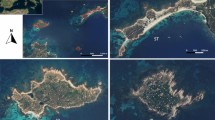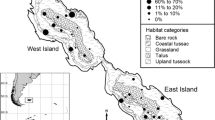Abstract
South Georgia has been the southernmost location where populations of invasive house mice Mus musculus are found. The distribution of mice was investigated at Cape Rosa and the Nuñez Peninsula, the two areas of South Georgia where the species is known to occur. Live-trapping and kill-trapping took place during March 2012, at the end of the austral summer, with traps in four grids (3.2–4.0 ha in area) and on 34 trap lines distributed across a range of habitats from the shoreline to 250 m above sea level. Mice were scarce, with just 68 captures in about 1750 trap nights. Mouse densities in tussock habitat were estimated at 2.1–2.8 mice/ha, with higher densities of 5.3–6.4 mice/ha along the coastline. Mice were found in all habitats apart from higher-altitude fellfield, but were relatively less abundant in tussock habitat with large numbers of seals. Mice were breeding at both sites with 58 % of mature females pregnant or lactating. Litter size (7.1 ± 2.3 embryos) and adult body mass (21.4 ± 4.6 g) were typical of most other island mice populations. Population densities of mice on South Georgia are two orders of magnitude lower than mouse densities measured at other sub-Antarctic islands. The very low population density and its restricted distribution, with most captures close to the shore, and the presence of large numbers of burrowing petrels and South Georgia pipits Anthus antarcticus at both sites, suggest that mice have a relatively limited impact on South Georgia’s vertebrate biodiversity.

Similar content being viewed by others
References
Angel A, Wanless RM, Cooper J (2009) Review of impacts of the introduced house mouse on islands in the Southern Ocean: are mice equivalent to rats? Biol Invasions 11:1743–1754
Avenant NL, Smith VR (2004) Seasonal changes in age class structure and reproductive status of house mice on Marion Island (sub-Antarctic). Polar Biol 27:99–111
Berry RJ, Bonner WN, Peters J (1979) Natural selection in House mice (Mus musculus) from South Georgia (South Atlantic Ocean). J Zool (Lond) 189:385–398
Black A, Poncet S, Wolfaardt A, Peters D, Hart T, Wolfaardt L, Tasker M, Rexer-Huber K (2012) Rodent eradication on South Georgia—preparation and evaluation: a summary report of activities during the 2011/2012 field season. Government of South Georgia and the South Sandwich Islands, Stanley
Black A, Parker G, Rexer-Huber K, Sommer E, Cuthbert RJ (2013) Kerguelen petrel (Lugensa brevirostris): a ‘new’ breeding species for South Georgia. Antarct Sci 25:69–70
Blackwell GL, Potter MA, McLennan JA (2002) Rodent density indices from tracking tunnels, snap-traps and Fenn traps: do they tell the same story? N Z J Ecol 26:43–51
Bolton M, Stanbury A, Baylis AMM, Cuthbert R (2014) Impact of introduced house mice (Mus musculus) on burrowing seabirds on Steeple Jason and Grand Jason Islands, Falklands, South Atlantic. Polar Biol 37:1659–1668
Bonner WN, Leader-Williams N (1977) House mice in South Georgia. Polar Rec 18:512
Bried J, Jouventin P (1991) Influence of breeding success on fidelity in long-lived birds: an experimental study. J Avian Biol 30:392–398
Burton R (2012) A field guide to the wildlife of South Georgia. South Georgia Heritage Trust, Dundee
Caut S, Casanovas JG, Virgos E, Lozano J, Witmer GW, Courchamp F (2007) Rats dying for mice: modelling the competitor release effect. Austral Ecol 32:858–868
Cook AJ, Poncet S, Cooper APR, Herbert DJ, Christie D (2010) Glacier retreat on South Georgia and implications for the spread of rats. Antarct Sci 22:255–263
Cory F, Wilson A, Priddel D, Carlile N, Klomp N (2011) Eradication of the house mouse (Mus musculus) from Montague Island, New South Wales, Australia. Ecol Manag Restor 12:102–109
Cuthbert R (2004) Breeding biology of the Atlantic petrel, Pterodroma incerta, and a population estimate of this and other burrowing petrels on Gough Island, South Atlantic Ocean. Emu 104:221–228
Cuthbert R, Hilton G (2004) Introduced house mice Mus musculus: a significant predator of threatened and endemic birds on Gough Island, South Atlantic Ocean? Biol Conserv 117:483–489
Cuthbert RJ, Visser P, Louw H, Rexer-Huber K, Parker G, Ryan PG (2011a) Preparations for the eradication of mice from Gough Island: results of bait acceptance trials above ground and around cave systems. In: Veitch CR, Clout MN, Towns DR (eds) Island invasives: eradication and management. IUCN, Gland, pp 47–50
Cuthbert RJ, Visser P, Louw H, Ryan PG (2011b) Palatability and efficacy of rodent baits for eradicating house mice (Mus musculus) from Gough Island, Tristan da Cunha. Wildl Res 38:196–203
Cuthbert RJ, Black A, Rexer-Huber K, Parker G, Sommer E (2012) Field trials for the eradication of house mice from South Georgia. RSPB Research Report No 48. Royal Society for the Protection of Birds, Sandy, Bedfordshire, UK. ISBN: 978-1-905601-35-6
Cuthbert RJ, Louw H, Lurling J, Parker G, Rexer-Huber K, Sommer E, Visser P, Ryan PG (2013) Low burrow occupancy and breeding success of burrowing petrels at Gough Island: a consequence of mouse predation. Bird Conserv Int 23:113–124
Gleeson JP (1981) Ecology of the house mouse Mus musculus Linnaeus, on Marion Island. MSc thesis, University of Pretoria, Pretoria
Goldwater N, Perry GLW, Clout MN (2012) Responses of house mice to the removal of mammalian predators and competitors. Austral Ecol 37:971–979
Harper GA (2010) Habitat use by mice during winter on subantarctic Auckland Island. N Z J Ecol 34:262–264
Hayne DW (1949) Two methods for estimating population from trapping records. J Mammal 30:399–411
Headland RK (2012) History of exotic terrestrial mammals in Antarctic regions. Polar Rec 48:123–144
Howald G, Donlan J, Galván JP, Russell JC, Parkes J, Samaniego A, Wang Y, Veitch D, Genovesi P, Pascal M, Saunders A, Tershy B (2007) Invasive rodent eradication on islands. Conserv Biol 21:1258–1268
Jones MGW, Ryan PG (2010) Evidence of mouse attacks on albatross chicks on sub-Antarctic Marion Island. Wildl Res 37:524–530
Jones AG, Chown SL, Gaston KJ (2003) Introduced house mice as a conservation concern on Gough Island. Biodivers Conserv 12:2107–2119
MacKay JWB, Russell JC, Murphy EC (2007) Eradicating house mice from islands: successes, failures and the way forward. In: Witmer GW, Pitt WC, Fagerstone KA (eds) Managing vertebrate invasive species: proceedings of an international symposium, Fort Collins, Colorado, August 7–9, 2007, pp 294–304
Moran PAP (1951) A mathematical theory of animal trapping. Biometrika 38:307–311
Murphy EC, Pickard CR (1990) House Mouse. In: King CM (ed) The handbook of New Zealand Mammals. Oxford University Press, Auckland, pp 225–245
Nelson L, Clark FW (1973) Correction for sprung traps in catch-effort calculations of trapping results. J Mammal 54:295–298
Peterjohn WT, Patterson JL, Barrett GW, Farrell MP (1981) Comparative accuracy of population estimators for enclosed small mammal populations. Acta Theriol Sin 26:459–468
Phillips RA (2010) Eradications of invasive mammals from islands: why, where, how and what next? Emu 110:i–vii
Phiri EE, McGeoch MA, Chown SL (2009) Spatial variation in structural damage to a keystone plant species in the sub-Antarctic: interactions between Azorella selago and invasive house mice. Antarct Sci 21:189–196
Prince PA, Poncet S (1996) The breeding and distribution of birds on South Georgia. In: Trathan PN, Daunt FHJ, Murphy EJ (eds) South Georgia: an ecological Atlas. British Antarctic Survey, Cambridge
Pye T (1993) Reproductive biology of the feral house mouse (Mus musculus) on subantarctic Macquarie Island. Wildl Res 20:745–758
Rexer-Huber K, Parker GC, Reeves M, Stanworth AJ, Cuthbert RJ (2013) Winter ecology of house mice and the prospects for their eradication from Steeple Jason (Falkland Islands). Polar Biol 36:1791–1797
Russell JC (2012) Spatio-temporal patterns of introduced mice and invertebrates on Antipodes Island. Polar Biol 35:1187–1195
Ryan PG, Cuthbert RJ (2008) The biology and conservation status of Gough Bunting Rowettia goughensis. Bull Br Ornithol Club 128:242–253
Smith VR, Steenkamp M (1990) Climatic change and its ecological implications at a subantarctic island. Oecologia 85:14–24
van Aarde RJ, Jackson TP (2007) Food, reproduction and survival in mice on sub-Antarctic Marion Island. Polar Biol 30:503–511
van Aarde RJ, Ferreira SM, Wassenaar TD (2004) Do feral house mice have an impact on invertebrate communities on sub-Antarctic Marion Island? Austral Ecol 29:215–224
Wanless RM, Angel A, Cuthbert RJ, Hilton GM, Ryan PG (2007) Can predation by invasive mice drive seabird extinctions? Biol Lett 3:241–244
Wanless RM, Ryan PG, Altwegg R, Angel A, Cooper J, Cuthbert R, Hilton GM (2009) From both sides: dire demographic consequences of carnivorous mice and longlining for the critically endangered Tristan albatrosses on Gough Island. Biol Conserv 142:1710–1718
Wanless RM, Ratcliffe N, Angel A, Bowie BC, Cita K, Hilton GM, Kritzinger P, Ryan PG, Slabber M (2012) Predation of Atlantic Petrel chicks by house mice on Gough Island. Anim Conserv 15:472–479
Acknowledgments
The project was funded by the UK Government’s Darwin Initiative Programme (Grant 18-017) and Overseas Territories Environment Programme (OTEP). The Government of South Georgia and the South Sandwich Islands (GSGSSI), British Antarctic Survey, and Royal Society for the Protection of Birds (RSPB) provided support and equipment. We thank St. John Payne, GSGSSI Fisheries Officer, and the Master and crew of the FPV Pharos SG, for transport and logistical support. Derek Brown, Nick Torr, and Sally Poncet commented on fieldwork plans, and James Russell and two anonymous reviewers provided feedback that improved this manuscript.
Author information
Authors and Affiliations
Corresponding author
Ethics declarations
Ethical standard
All applicable international, national and institutional guidelines for the care and use of animals were followed, and procedures were in accordance with the ethical standards of RSPB and GSGSSI.
Rights and permissions
About this article
Cite this article
Parker, G.C., Black, A., Rexer-Huber, K. et al. Low population density and biology of an island population of house mice Mus musculus on South Georgia. Polar Biol 39, 1175–1181 (2016). https://doi.org/10.1007/s00300-015-1831-8
Received:
Revised:
Accepted:
Published:
Issue Date:
DOI: https://doi.org/10.1007/s00300-015-1831-8




